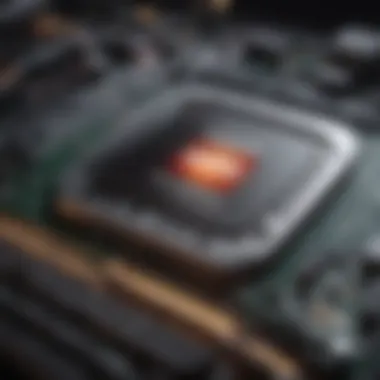Latest Generation AMD Processors: A Deep Dive


Intro
The landscape of processors is ever-evolving, shaped by innovations that push the boundaries of technology and performance. AMD has emerged as a strong competitor in this arena, especially with the latest generation of processors that blend efficiency with power. Understanding these advancements is crucial for tech-savvy individuals and enthusiasts alike. This section explores key aspects such as architectural enhancements, performance benchmarks, and the overall impact of these processors in various fields, including gaming and artificial intelligence.
The latest AMD processors demonstrate not just improvements on previous architectures but also a response to market trends and user demands. By analyzing these trends, one can glean how AMD prepares to solidify its position among competitors like Intel and NVIDIA. This comprehensive overview aims to inform the reader about the significant strides made by AMD and their implications for future applications in technology.
Preface to AMD Processors
The landscape of computing has evolved significantly over the past few decades. AMD, or Advanced Micro Devices, has become a vital player in this transformation, particularly in the realm of processors. This section aims to highlight the importance of AMD processors in contemporary technology, framing the context for further exploration of their architectural innovations and performance metrics.
Overview of AMD's Evolution
AMD has witnessed remarkable growth since its inception in 1969. Initially a semiconductor company, it ventured into microprocessors in the 1970s. Over the years, AMD has developed a range of processors, consistently pushing technological boundaries. The introduction of the first x86 compatible processors marked a pivotal moment in the company’s history. Eventually, the launch of the Ryzen series cemented AMD's reputation as a formidable competitor against industry giants like Intel.
The evolution of AMD’s technology reveals a dedication to enhancing performance while optimizing power efficiency. With each new generation, AMD integrates cutting-edge architecture, targeting both consumer and enterprise sectors. Their commitment to research and innovation has led to significant advancements in multi-core technology and parallel processing. This trajectory showcases AMD's resilience and adaptability in an ever-changing tech environment.
Importance of Processor Technology
Processor technology is fundamental to computing. These components execute instructions that power everything from simple applications to complex simulations. In an era where digital experiences heavily rely on processing capabilities, the importance of keeping pace with advancements cannot be overstated.
AMD's processors cater to diverse needs, offering solutions for casual computing to high-end gaming and data analysis. This versatility is crucial, as consumers today expect systems that can handle demanding applications seamlessly. Moreover, as gaming and content creation grow in popularity, the role of processors becomes even more critical. High-performance processors ensure a smooth user experience, reducing lag and allowing for faster rendering times in graphical applications.
Having reliable and efficient processors also translates into economic benefits for businesses. Improved processor performance can lead to enhanced productivity, directly impacting bottom lines. For consumers, investing in the latest AMD processors provides confidence in future-proofing their technology needs. Understanding these dynamics lays the groundwork for the detailed analysis of AMD's latest generations that follows.
Architectural Innovations of the Latest Generation
Architectural innovations play a vital role in the evolution of processors. In the context of AMD, these innovations not only enhance performance but also cater to the growing demands of various computing tasks. The latest generation AMD processors represent a significant leap forward in architecture, merging cutting-edge technology with user-centric design. This section will elucidate the specific elements and benefits that are encompassed in this architectural evolution, as well as the considerations it brings to both developers and consumers alike.
Zen Architecture Explained
The Zen architecture marks a pivotal change in AMD's processor design. Introduced in 2017, it laid the groundwork for subsequent generations. Zen focuses on improving performance metrics while also optimizing power efficiency. Its core building blocks allow for increased core counts without skyrocketing power consumption. Each core is capable of simultaneous multithreading, which translates to enhanced parallel processing capabilities.
Critical aspects of the Zen architecture include its modular design and its ability to scale performance across different markets. This design approach not only grants AMD flexibility in targeting various segments but also means that advancements made in one product line can often be utilized in others. The resulting processors exhibit better thermal management and overall performance boosts.
Improved Efficiency and Performance
Efficiency and performance are at the forefront of the latest AMD processors' innovations. Several improvements have been realized in recent designs, from power efficiency to computational throughput. With the new manufacturing processes, these processors consume less power per operation while providing higher stability under load.
The advancements in clock speeds and cache memory further enhance performance. By optimizing memory bandwidth and reducing latency, AMD processors can execute tasks more swiftly. These enhancements are especially beneficial in demanding scenarios such as gaming and content creation. Notably, improved efficiency also contributes to longer system lifespans, which benefits both consumers and enterprises.
Integration of Advanced Manufacturing Processes
The transition to advanced manufacturing processes is a discussion point that cannot be ignored. AMD has adopted new fabrication techniques, such as the 7nm process technology, which allows for greater transistor density. This enables more cores within the same physical space, leading to improved performance while maintaining sensible heat and power usage.
The application of improved manufacturing also leads to the integration of superior features, such as enhanced graphics capabilities directly onto the chip. This results in better performance when using integrated graphics, which is particularly relevant for users focusing on lightweight gaming or content applications. Furthermore, these advancements facilitate smoother performance in multi-threaded applications and intensive workloads, setting a new standard within the industry.
Performance Metrics of AMD Processors
Understanding the performance metrics of AMD processors is crucial for anyone looking to evaluate these technologies effectively. Performance metrics serve as the benchmark for assessing the capabilities of processors concerning various tasks. They give consumers insights into how well a processor performs in gaming, content creation, and other demanding applications.
Key performance metrics include clock speed, core count, thermal design power, and caching capabilities. Each of these metrics contributes differently to the processor's overall performance, and consumers often analyze these indicators before making purchasing decisions.
Benchmarking Methodologies
When we talk about benchmarking methodologies, it is about standardizing the way we evaluate processor performance. Different types of benchmark tests are used to measure how well AMD processors perform under various loads.


These tests typically include synthetic benchmarks like Cinebench and real-world scenarios such as gaming tests or rendering tasks. Both synthetic and real-world data combined provide a clearer understanding of a processor’s practical performance.
- Synthetic Benchmarks: These are designed to focus on specific capabilities of a processor, such as single-core and multi-core performance.
- Real-World Tests: Here, actual applications are run to see how well the processor fares in common usage scenarios.
Both types of tests are essential for a comprehensive evaluation.
Comparison with Previous Generations
A comparative analysis with previous generations highlights the advancements AMD has made over time. The evolution from the Ryzen 1000 series to the Ryzen 5000 series is marked by significant improvements in both architecture and efficiency.
Some areas of improvement may include:
- IPC (Instructions Per Clock): The latest generations show a notable increase in IPC, translating directly to enhanced performance without needing higher clock speeds.
- Power Consumption: Efficiency has improved, allowing users to get more performance per watt compared to earlier models.
- Integrated Graphics: With the introduction of models featuring improved integrated graphics, users benefit even without a discrete GPU.
This progression shows how AMD has responded to market needs and technological advancements.
Comparative Analysis with Competitors
Analyzing AMD processors against competitors like Intel is vital for understanding where they stand in the market. AMD's latest chips often offer more cores at similar price points, leading to better multi-threaded performance in many applications.
Key factors include:
- Price to Performance Ratio: AMD has been known to provide superior value for performance, especially in budget-sensitive segments.
- Feature Set: Certain features such as PCIe 4.0 support and larger amounts of cache memory distinguish AMD processors from their counterparts.
- Thermal Performance: AMD's thermal management has also improved, leading to better performance under load compared to competitors that may throttle.
"The competitive landscape in processor technology requires constant evolution to meet consumer demands and technological standards."
A well-rounded understanding of these performance metrics is essential for any tech enthusiast, gamer, or content creator seeking to leverage the capabilities of AMD processors.
Applications of Latest Generation AMD Processors
The relevance of the applications of the latest generation AMD processors cannot be overstated. As these processors continue to evolve significantly, they have carved unique niches in various fields, including gaming, content creation, and artificial intelligence. Understanding the implications of these processors in different applications helps consumers and developers alike make informed decisions.
Gaming Performance
Modern gaming demands powerful hardware to deliver immersive experiences. The latest AMD processors, especially those based on the Zen architecture, provide robust frameworks to handle high-resolution graphics and intensive computational tasks.
The AMD Ryzen series has gained acclaim for its multitasking capabilities, which allows users to run complex game engines while maintaining smooth gameplay. The processors exhibit increased clock speeds and core counts, making them suitable for today’s demanding games.
Furthermore, with support for technologies like AMD FreeSync and Ray Tracing, gaming performance is enhanced significantly. Gamers can expect improved frame rates and more dynamic visuals, which elevate the overall gaming experience. These processors really bridge the gap between performance and realism in gaming.
Content Creation and Productivity
Content creation has undergone a revolution as more creators turn to AMD processors for their performance capabilities. The latest generations provide immense power for video editing, graphic design, and 3D rendering tasks. Adobe Premiere Pro and DaVinci Resolve, among others, benefit from the optimization that AMD processors offer.
The multi-core performance is particularly beneficial for rendering videos and applying effects in real-time. Creators find the latest AMD Threadripper series especially appealing due to its exceptional core counts, which allow for faster processing and smoother workflow. This particular series underpins the demanding needs of professionals in graphics, giving them the edge needed to produce high-quality content quickly.
AI and Machine Learning Applications
Artificial Intelligence is another sphere where AMD processors shine. They accommodate extensive data processing and complex algorithms that are essential for machine learning tasks. The architecture of the latest AMD chips supports parallel processing, which accelerates training times for models significantly.
Research institutes and tech companies leverage the power of these processors, particularly for workloads such as data analysis, image recognition, and natural language processing. The integration of Radeon GPUs with AMD’s CPUs further amplifies this capability, offering a complete solution for AI workloads. As businesses continue to adopt AI technology, the role of AMD processors in facilitating this transition becomes clear.
"The advancements in AMD processor technology are not just beneficial but essential for high-performance applications across various fields."
In summary, these applications demonstrate the versatility and prowess of the latest AMD generation processors. The performance in gaming, content creation efficiencies, and advancements in AI and machine learning drive their utilization across diverse sectors. For anyone considering hardware options, the impact of these processors across different areas of use is critical to understanding their value.


Impact on the Market
Understanding the impact of the latest generation AMD processors on the market is crucial to grasping the broader implications for technology and consumer choices. AMD has made impressive strides in not only delivering powerful performance but also shaping overall market dynamics within the semiconductor industry. This section explores three key elements that highlight AMD's position: competitive stance, prevailing market trends, and future outlook.
AMD's Competitive Position
AMD's competitive position has evolved significantly. Once primarily viewed as an alternative to Intel, AMD is now considered a leading innovator. The recent Ryzen and EPYC processors showcase notable enhancements in both performance and efficiency, establishing AMD as a serious contender. The combination of high core counts and better multi-threading capabilities have made AMD the go-to choice for many users, including gamers and content creators. This shift challenges traditional notions of what a high-performance processor should be.
One of AMD's notable strategies is its focus on delivering value. Unlike its competitors, AMD offers several options within various price brackets, catering to diverse consumers, from budget gamers to high-end workstation users. The competitive pricing paired with superior performance metrics creates a compelling proposition for customers to choose AMD.
Market Trends and Consumer Preferences
As AMD gains traction, various market trends are emerging. Interest in high-performance processors is on the rise, especially among gamers and professionals who demand reliability. The current trend emphasizes the need for multi-core performance and energy efficiency, which aligns perfectly with AMD's architectural design principles.
Consumer preferences are shifting towards flexibility and performance. Users are looking for processors that can handle multiple tasks efficiently, whether it's gaming, streaming, or content creation. AMD's advancements such as the Zen architecture address these demands, providing excellent functionality for multiple scenarios. Additionally, as awareness of technology increases, more consumers seek brands that provide value and innovation.
Future Prospects for AMD
The prospects for AMD are promising. With continuous improvements in processor design and manufacturing processes, AMD is positioned to expand its market share further. The ongoing development in AI and machine learning applications provides a new arena for growth. AMD's processors are now being adopted in data centers and cloud environments, indicating increasing versatility and demand.
Nevertheless, challenges remain. Competition from Intel and newer entrants can disrupt AMD's trajectory. However, if AMD maintains its pace of innovation and reinforces its competitive position, it can significantly shape the future of processor technology. The market will likely see AMD continuing to push the envelope, enhancing performance while reducing costs for consumers.
"The semiconductor market is at a crossroads where innovation is a key driver of success. AMD’s strategic moves are vital for its growth in this competitive landscape."
In summary, the impact of the latest generation AMD processors on the market is substantial. Their competitive position, responsiveness to trends, and strong future prospects contribute to reshaping consumer choices and industry standards.
Technical Specifications Overview
Understanding the technical specifications of the latest generation AMD processors is crucial for anyone looking to optimize their computing experience. This section helps buyers make informed decisions by breaking down key specs that define performance and applicability. By focusing on details such as clock speed, core count, and thermal design power, one can gauge what these processors bring to the table in various contexts.
Key Specifications of Processors
Core Count: The number of cores in a processor significantly influences its capability to manage multiple tasks. For the latest AMD processors, options often range from 6 to 16 cores. More cores generally lead to better multitasking and enhanced performance in heavily threaded applications, like video editing or 3D rendering.
Clock Speed: Measured in gigahertz (GHz), clock speed indicates how quickly a processor can perform tasks. AMD processors may have base and boost clock speeds, with the latter allowing the CPU to temporarily exceed its base speed under high demand. Higher clock speeds can enhance gaming performance, where quick response times are essential.
Cache Memory: The L2 and L3 cache sizes affect data retrieval speeds. A larger cache can speed up commonly accessed data, improving overall processing efficiency.
Integrated Graphics: Some AMD processors come with integrated graphics, allowing users to run applications without a dedicated GPU. This feature could be appealing for budget-conscious buyers who do not require intensive graphics processing.
Thermal and Power Considerations
Thermal performance and power consumption are pivotal aspects when evaluating AMD processors. Each model has a specified Thermal Design Power (TDP) rating, which indicates how much heat the CPU generates under maximum load.
Managing heat effectively is crucial to maintaining performance and longevity, particularly during intensive tasks like gaming or rendering. AMD processors often employ sophisticated cooling solutions to ensure optimal thermal performance, which also plays a role in overclocking scenarios.
Compatibility with Motherboards
When selecting an AMD processor, motherboard compatibility cannot be overlooked. Each processor family has specific socket types and supported chipsets. For instance, the Ryzen series typically utilizes the AM4 socket.
Buyers should ensure that their selected motherboard not only fits the processor's socket but also supports the required features like PCIe lanes and memory speeds. This aspect directly affects the potential for future upgrades as well.
"A thorough understanding of technical specifications empowers consumers to make well-informed decisions tailored to their computing needs."
By considering these specifications, consumers can find a processor that not only meets their current needs but also stays relevant for years to come.


Consumer Choice: Selecting the Right AMD Processor
Choosing the right AMD processor is a crucial decision for consumers, especially in today’s diverse technology landscape. The variety in AMD's processor lineup caters to several distinct use cases, from gaming and content creation to AI applications. Understanding the available options allows users to make informed decisions that match their specific needs. This section provides insights into identifying use cases, budgeting, and future-proofing purchases.
Identifying Use Cases
When selecting an AMD processor, identifying the intended use case is essential. Gamers might prioritize higher clock speeds and cores that excel in multitasking, while content creators may need more processing power for rendering videos or running resource-intensive software.
Key considerations include:
- Gaming: For games that are CPU-intensive, AMD Ryzen 7 or Ryzen 9 may offer the best performance.
- Content Creation: Ryzen Threadripper models are increasingly favored for multi-threaded applications due to their higher core counts.
- General Use: For users who do web browsing, office applications, or light gaming, Ryzen 3 or Ryzen 5 will suffice.
It is important to match the CPU's performance characteristics with the specific tasks you plan to perform. This ensures optimal performance and value.
Budget Considerations
Budget constraints play a significant role in the decision-making process. AMD processors tend to offer a range of prices, providing options from entry-level to high-end models. Understanding the budget can help narrow down choices effectively.
Here are some points to consider when budgeting for a processor:
- Price vs. Performance: AMD processors often deliver more performance per dollar than competitors. Evaluate what kind of performance is necessary for your needs to determine a reasonable budget.
- Additional Costs: Consider whether your budget includes the cost of a new motherboard or cooling solutions, as certain high-end CPUs may require additional components.
- Future Proofing: Investing slightly more in a capable processor may pay dividends in the long run, helping to avoid the need for upgrades shortly after purchase.
Future-proofing Your Purchase
As technology evolves, so do the demands placed on processors. Future-proofing your decision involves selecting a model that may remain relevant over the next few years. This is especially critical for gamers and professionals whose workloads will likely increase.
Strategies for future-proofing include:
- Higher Core Counts: Invest in processors with more cores, like the AMD Ryzen 9 series, to handle future workloads, especially in video editing and gaming.
- Latest Generation Models: Always consider the most current generation. The technology tends to improve significantly every few years.
- Compatibility: Ensure that the selected processor is compatible with the sockets of motherboards that support potential future upgrades.
"Selecting the right AMD processor means aligning your choice with your unique needs, budget constraints, and long-term goals."
Ending and Future Perspectives
The conclusion and future perspectives section serves as a critical anchor for the comprehensive analysis of the latest generation AMD processors. It synthesizes the findings discussed in earlier sections, offering a holistic view of AMD's position in the market and its technological advancements. This part emphasizes the relevance of the reviewed architecture, performance metrics, and application fields, substantively enriching the reader's understanding of the ongoing evolution in processor technology.
In our exploration, we highlighted how AMD's architectural innovations not only enhance efficiency but also facilitate robust performance across diverse computing needs. The insights into AMD's performance in gaming, content creation, and artificial intelligence illustrate the processor's adaptability and varied applications. The implications of these advancements extend far beyond mere numbers on benchmarks; they frame the practical, tangible benefits to end users.
As we look forward, several specific elements emerge regarding AMD's path ahead:
- Technological Advancements: AMD is poised to continue leveraging its Zen architecture, developing more efficient cores that can meet the demands of new software environments.
- Market Strategies: With a firm grip on competitive pricing and compelling performance, AMD's strategy may pivot to solidifying brand loyalty while expanding into new markets such as enterprise solutions and high-performance computing.
- Future-proofing: For consumers and businesses alike, choosing the right AMD processor involves more than immediate performance; it necessitates a consideration of future needs in an ever-evolving tech landscape.
"The competitive landscape of processors is evolving rapidly, and AMD's focus on integration and innovation will be crucial in maintaining its edge."
Synthesis of Findings
The detailed analysis throughout the article has revealed several key insights regarding the latest generation AMD processors. First, AMD's commitment to improving computational power while efficiently managing energy consumption is evidenced in the performance gains of its latest models. Metrics consistently indicated that AMD processors are now optimized for a variety of use cases, reclaiming a significant market share from longtime rival Intel.
Second, the architectural advancements, particularly within the Zen architecture family, have resulted in better multi-threading capabilities, crucial for resource-intensive tasks. The benchmarks suggest that this generation of AMD processors not only matches but often exceeds previous generations, welcoming a new era of potential in both gaming and productivity applications.
Lastly, the overall adaptability of these processors in increasingly diverse applications points to their importance in shaping future computing needs. Whether for gaming or AI research, AMD is positioning itself strategically in a continuously competitive field.
The Path Ahead for AMD Technologies
Looking into the future, the trajectory for AMD technologies appears promising yet competitive. The focus will likely remain on enhancing core performance while integrating more advanced features that cater to both existing and emergent technological needs.
Improved integration with emerging technologies, such as AI and machine learning, will play a vital role as AMD continues to build specialized products to meet these markets. The adoption of 3D chip stacking and memory integration through advanced techniques like chiplet architecture could redefine performance capabilities.
Consumers may also see more tailored solutions for different segments, facilitating a more nuanced approach to processor selection, which aligns with varied user needs.
In summary, the future for AMD technologies hinges on continued innovation, strategic market positioning, and responsiveness to consumer demands in a fast-paced tech landscape. AMD's ability to adapt will be crucial in maintaining its competitive edge and solidifying its role as a powerhouse in the semiconductor industry.







